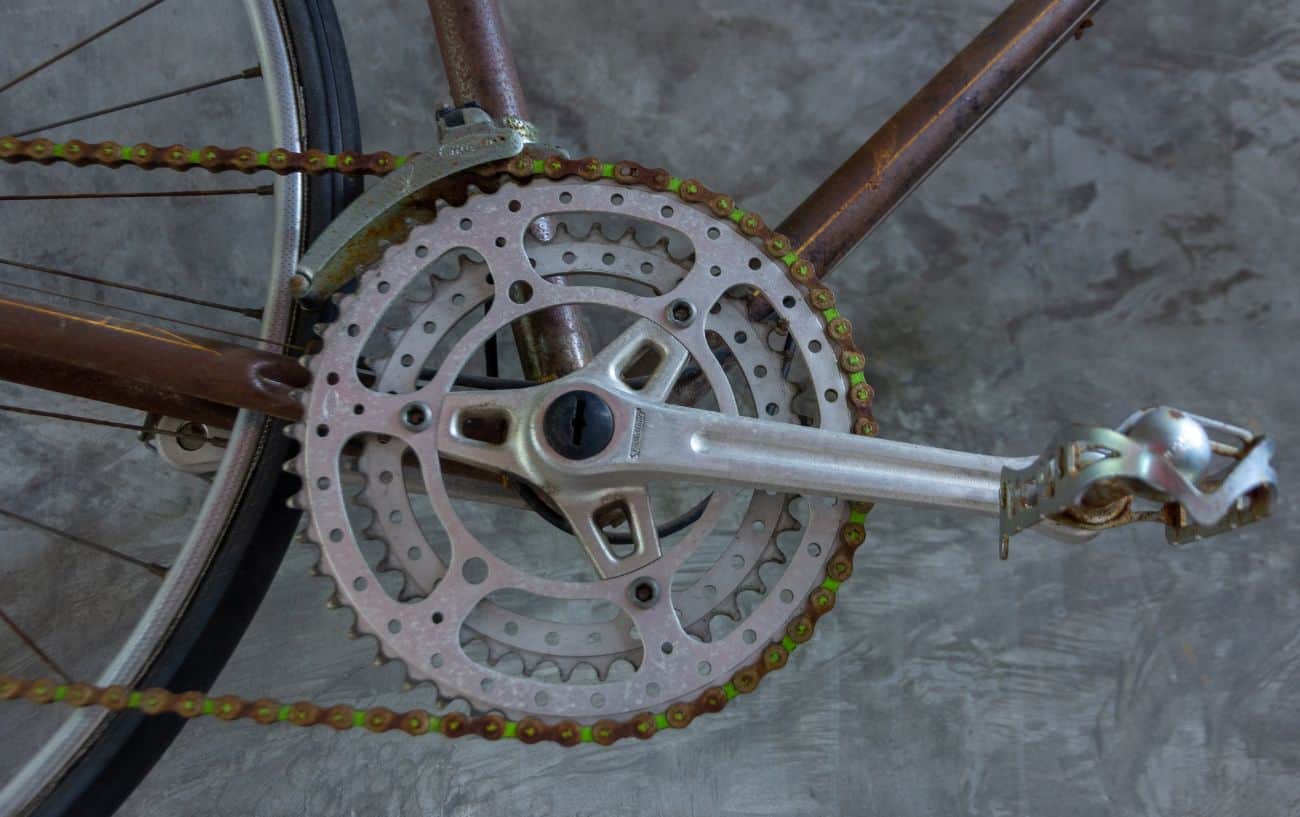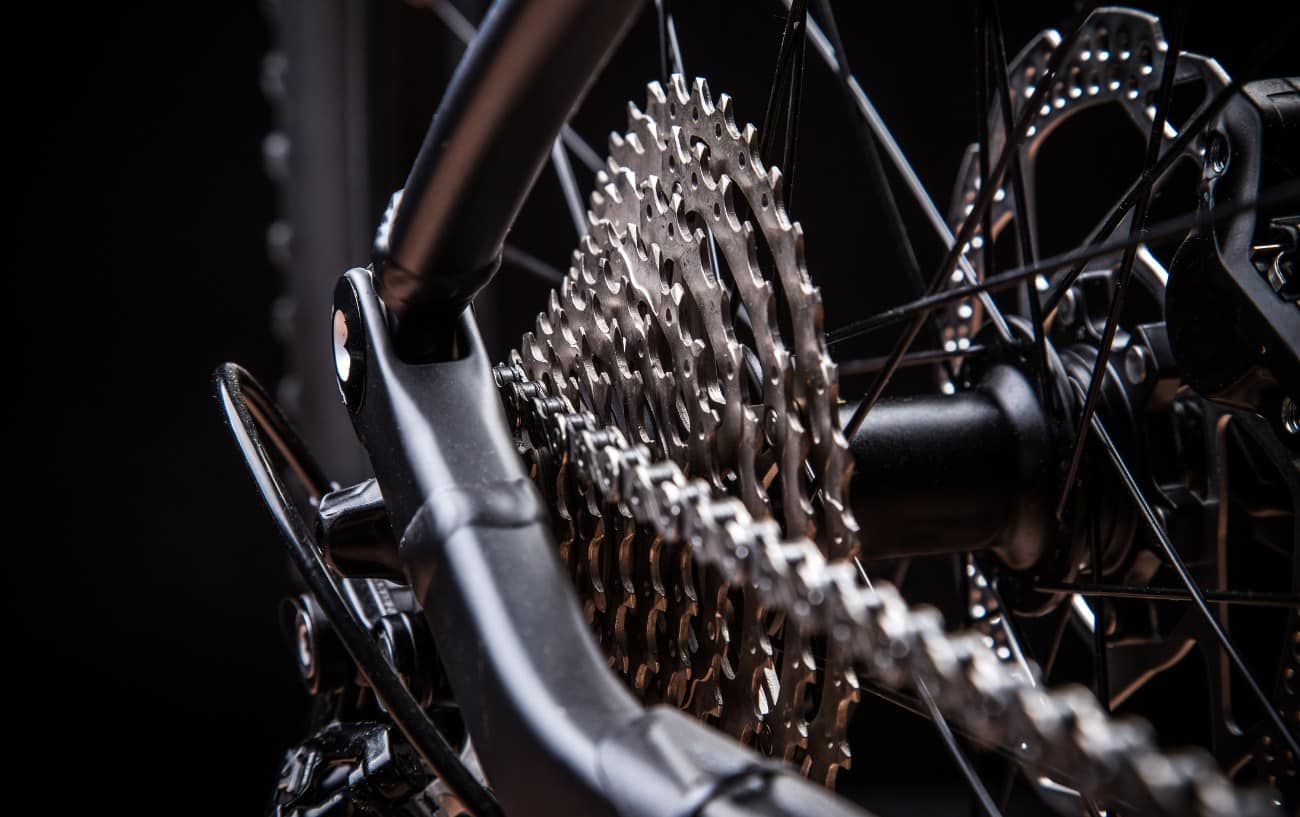An integral part of your machine, the bicycle groupset refers to all of the components that allow you to propel yourself forwards and bring yourself to a stop.
Whether you’re new to cycling or a two-wheel fanatic, it may not be obvious exactly how your bike works. The parts that comprise the drivetrain and the braking system are called the groupset.
These include:
- Brakes
- Chainset
- Cassette
- Bottom Bracket
- Front and Rear Derailleurs
- Brake and Gear Levers
- Chain
These components work together intricately to create an efficient machine that allows the rider to convert their human power into kinetic energy, moving the bike. But what are these components, and how do they work together to achieve this?
We’ll get you up to speed on this and all things bike groupset, covering:
- What Is A Bicycle Groupset, And What Are Its Parts?
- 3 Key Groupset Manufacturers: Shimano, Campagnolo, and SRAM
Ready to kick into gear?
Let’s dive in!

What Is A Bicycle Groupset, And What Are Its Parts?
Essentially, the groupset is everything on the bike that makes it move and stop. The drivetrain, shifters, and brakes together comprise the groupset.
The components which make up the groupset typically include:
- Brakes
- Chainset
- Cassette
- Bottom Bracket
- Front and Rear Derailleurs
- Brake and Gear Levers
- Chain
Check out our All Parts of a Bike Explained guide here!
If you’re building a bike or upgrading its components, you can usually purchase all of these together as a single groupset. However, it’s also possible to purchase each part individually, though it often works out more expensive.
Groupsets from different manufacturers (and even from different ranges within the same manufacturer) are often incompatible with one another – although there are plenty of exceptions! If in doubt, check with your local bike shop before buying.
The Brakes

The brakes are what bring the bike to a stop.
These are most often either disc brakes or rim brakes (usually cantilever brakes). Cantilever brakes are comprised of two pads that sit on either side of the rims. These pads squeeze around the rim through action on the brake levers, applying friction on the rims, which forces the wheels to stop spinning.
Disc brakes, on the other hand, sit on the hubs and are comprised of discs that squeeze the rotor instead of the wheel, and again apply friction that forces the wheel to stop spinning.
- Check out our Complete Guide to Bicycle Brake Types here!
Chainset

The chainset consists of the chainrings (the front set of gear cogs) and the crank arms (the parts which connect the pedals to the chainrings).
- Check out our Complete Guide to Bicycle Chainrings here!
Cassette

The cassette is the group of gear sprockets attached to the back wheel.
The cassette is the interface between the chain and the rear wheel, allowing the chain’s energy to propel the bike forward. Each of the cogs in the cassette provides a different gear ratio, which can be changed through action on the shifters.
- Check out our Complete Guide to Bike Cassettes here!
Bottom Bracket

The bottom bracket is the set of bearings that sit at the junction between the down tube, seat tube, and chainstays. It is where the chainset is secured to the bike and rotates freely with the cranks whilst pedaling.
Front and Rear Derailleurs

The derailleurs guide the chain onto different cogs, putting the bike into different gears.
The front derailleur is secured to the seat tube and fits over the chain. It moves the chain between the chainrings when actuated by the shifter.
The rear derailleur moves the chain between the sprockets of the cassette. It also contains a spring and jockey wheels to maintain tension in the chain regardless of the size of the gears it sits on.
- Check out our Complete Guide to Bike Derailleurs here!
Brake and Gear Levers

The brake levers are connected to the brakes by cables, which when pulled, force the brakes into action. The shift levers move the derailleurs, allowing you to change gear.
The brake and shift levers are often combined into a single unit, especially on drop handlebars. For bikes with friction shifters (typically older bikes, along with some modern touring bikes), the gear levers are usually located on the down tube.
The Chain

The chain brings the whole drivetrain together: it rests on the cassette and chainrings and is guided by the derailleurs. The rotation of the cassette is coupled to that of the chainset through the rotation of the chain.
3 Key Groupset Manufacturers: Shimano, Campagnolo, and SRAM
Shimano Bicycle Groupsets

Now the biggest name in bicycle components, Shimano is a Japanese manufacturing firm founded in 1921. Despite their modern-day dominance, they didn’t begin producing bicycle components until the 1970s.
European manufacturers struggled to keep up with demand for components during the “Bike Boom” of the 1970s. Shimano took advantage of thisgap in the market by designing its own range of high-quality bicycle groupsets.
Shimano demonstrated their innovation with their pioneering indexed shifting system in 1985, now found on almost every modern bike produced. Their market domination became apparent in the ’90s, however, when they integrated their components with each other, making it more difficult to mix and match.
Some viewed this as an attempt to monopolize the industry, but Shimano asserted that it was merely to ensure the performance of their products. Campagnolo and SRAM soon followed suit, which now makes it difficult to have a mix of components from different companies in your groupset.
Shimano produces groupsets for both road bikes and mountain bikes. For road bikes, their top-of-the-range product is the Dura-Ace groupset, with modern models costing around $4000. Generally, their new technologies and innovations begin in this flagship range and trickle down into the cheaper ranges as the technology matures.
The full hierarchy for Shimano road bike groupsets is:
- Dura-Ace (flagship)
- Ultegra
- 105
- Tiagra
- Sora
- Claris (entry-level)
Riders using Shimano bicycle groupsets in the Grand Tours will of course be using Dura-Ace. It’s a remarkable sign of Shimano’s dominance that every male Grand Tour winner since 2020 has sported a Dura-Ace groupset on their bikes.
- Check out our Ultimate Shimano Groupset Guide: Road Bike Edition and Mountain Bike Edition here!
Campagnolo Bicycle Groupsets

Campagnolo – sometimes referred to as ‘Campy’ or ‘Campag’ – is the oldest and most prestigious of the three major bicycle groupset manufacturers.
They are steeped in history, founded in 1933 by Tullio Campagnolo in Vicenzo, Italy. Tullio was a road cyclist in the 1920s, and through his experience had a number of ideas on how to improve the components on his bike.
Tullio himself came up with the idea for quick-release bike components with his ingenious Cambio Corsa mechanism, one of Campagnolo’s first major innovations. Since then, Campagnolo has been a pioneer in the groupset market, amassing 135 patents for original adaptations or inventions of groupset components.
Campagnolo groupsets have been on more Grand Tour-winning bikes than any other brand. They have loyal support from many famous riders, with Gino Bartali, Vincenzo Nibali, and even Eddie Merckx having won tours with Campagnolo groupsets.
In fact, Merckx, the all-time most successful road cyclist, was a personal friend of Tullio Campagnolo, and a big fan of Campy components. He exclusively used Campagnolo groupsets, and even pitched in with design to produce the most lightweight components possible for Merckx’s Tour de France-winning bike in 1972.
Unlike their competitors, SRAM and Shimano, Campagnolo exclusively cater to the high-end and mid-range groupset markets, never compromising the quality of their equipment.
However, this is reflected in price, as the new Campagnolo Super Record EPS groupset retails at almost $5000!
The current Campagnolo road bike groupset hierarchy is:
- Super Record (flagship)
- Record
- Chorus
- Centaur (mid-range, Shimano 105 equivalent)
There are also a number of older Campagnolo groupset models no longer in production. However, because of the desirability of vintage Campagnolo components and their outstanding reputation for longevity, you’ll still often see them fitted on second hand bikes.
These older, discontinued Campagnolo bike groupsets include:
- Potenza
- Mirage
- Athena
- Veloce
Check out our Complete Guide to Campagnolo Groupsets here!
SRAM Bicycle Groupsets

SRAM are the new kids on the block when it comes to bicycle groupsets, but they now command a huge slice of the market and offer serious competition to Campagnolo and Shimano.
Founded in 1987 in Chicago, Illinois, the name is a mash-up of SRAM’s founders: Scott, Ray, and Sam. Over the past two decades, SRAM has absorbed seven other bike component manufacturers, accelerating their growth.
SRAM announced themselves with a bang. Their first major innovation was the grip – or “twist” – shifter, originally marketed for road bikes but not not an uncommon sight on a high-end mountain bike.
Initially a manufacturer solely of road bike components, SRAM initially struggled to compete with the giants of Shimano and Campagnolo. In response, they capitalized on the explosion of mountain biking’s popularity, and by 1993 had effectively left the road bike market.
In 2004, they made a well-recieved comeback to road bike groupsets, creating two new ranges: Force and Rival.
Their top-of-the-range road bike groupset, the not-very-catchy RED eTap AXS, is a serious rival for Dura-Ace and Super Record.
The eTap AXS technology marked a huge investment by SRAM into wireless electronic gear shifting. It too comes with a hefty price tag, however, retailing at around $3000.
The SRAM road bike groupset hierarchy is:
- RED (flagship)
- Force
- Rival
- Apex (entry-level)
Check out our Ultimate SRAM Groupset Guide: Road Bike Edition here!
Now you know all about Bicycle groupsets…

You might be wondering how to find a good deal, especially after hearing the eye-watering prices of state-of-the-art groupsets. It can be cheaper to buy a bike complete second-hand, and make sure that you look out for the high-level groupsets.
Before you empty your bank account, it’s worth considering that some of the older versions of the top-end models like Super Record, Dura-Ace and RED can be found much much cheaper used. Remember that these were still pioneering groupsets and required most of the attention of these market giants for their invention.
An slightly older version of Shimano’s Ultegra groupset, for example, is still likely to give a lot more bang-for-buck than a brand-new Tiagra group.
It’s also worth considering that if you already have components from one of these brands, it is very difficult to mix and match the brands to build a complete bicycle groupset. It is possible though, and various guides can be found on bike forums online.



